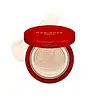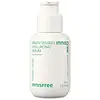What's inside
What's inside
 Key Ingredients
Key Ingredients

 Benefits
Benefits

 Concerns
Concerns

No concerns
 Ingredients Side-by-side
Ingredients Side-by-side

Water
Skin ConditioningCI 77891
Cosmetic ColorantCyclopentasiloxane
EmollientEthylhexyl Methoxycinnamate
UV AbsorberDimethicone
EmollientPhenyl Trimethicone
Skin ConditioningEthylhexyl Salicylate
UV AbsorberButylene Glycol
HumectantLauryl PEG-10 Tris(Trimethylsiloxy)Silylethyl Dimethicone
EmulsifyingNiacinamide
Smoothing1,2-Hexanediol
Skin ConditioningCI 77492
Cosmetic ColorantPEG-9 Polydimethylsiloxyethyl Dimethicone
EmulsifyingGlycerin
HumectantCentella Asiatica Extract
CleansingChamomilla Recutita Extract
Skin ConditioningMacadamia Ternifolia Seed Oil
EmollientOlea Europaea Fruit Oil
MaskingSimmondsia Chinensis Seed Oil
EmollientVitis Vinifera Seed Oil
EmollientButylene Glycol Dicaprylate/Dicaprate
EmollientCetyl PEG/PPG-10/1 Dimethicone
EmulsifyingMethyl Hydrogenated Rosinate
PerfumingIsododecane
EmollientMagnesium Sulfate
Disteardimonium Hectorite
StabilisingAcrylates/Polytrimethylsiloxymethacrylate Copolymer
Skin ConditioningGlyceryl Caprylate
EmollientPolypropylsilsesquioxane
Vinyl Dimethicone/Lauryl Dimethicone Crosspolymer
Aluminum Hydroxide
EmollientStearic Acid
CleansingAlumina
AbrasiveTriethoxycaprylylsilane
Ethylhexylglycerin
Skin ConditioningAdenosine
Skin ConditioningHydrogenated Castor Oil Isostearate
Skin ConditioningPEG-10 Dimethicone
Skin ConditioningSilica
AbrasivePolymethyl Methacrylate
Pullulan
Caprylic/Capric Triglyceride
MaskingHydrogenated Lecithin
EmulsifyingSucrose Palmitate
EmollientAcrylates/Dimethicone Copolymer
Skin ConditioningCeramide NP
Skin ConditioningSodium Stearoyl Glutamate
CleansingDisodium EDTA
Parfum
MaskingCI 77491
Cosmetic ColorantCI 77499
Cosmetic ColorantWater, CI 77891, Cyclopentasiloxane, Ethylhexyl Methoxycinnamate, Dimethicone, Phenyl Trimethicone, Ethylhexyl Salicylate, Butylene Glycol, Lauryl PEG-10 Tris(Trimethylsiloxy)Silylethyl Dimethicone, Niacinamide, 1,2-Hexanediol, CI 77492, PEG-9 Polydimethylsiloxyethyl Dimethicone, Glycerin, Centella Asiatica Extract, Chamomilla Recutita Extract, Macadamia Ternifolia Seed Oil, Olea Europaea Fruit Oil, Simmondsia Chinensis Seed Oil, Vitis Vinifera Seed Oil, Butylene Glycol Dicaprylate/Dicaprate, Cetyl PEG/PPG-10/1 Dimethicone, Methyl Hydrogenated Rosinate, Isododecane, Magnesium Sulfate, Disteardimonium Hectorite, Acrylates/Polytrimethylsiloxymethacrylate Copolymer, Glyceryl Caprylate, Polypropylsilsesquioxane, Vinyl Dimethicone/Lauryl Dimethicone Crosspolymer, Aluminum Hydroxide, Stearic Acid, Alumina, Triethoxycaprylylsilane, Ethylhexylglycerin, Adenosine, Hydrogenated Castor Oil Isostearate, PEG-10 Dimethicone, Silica, Polymethyl Methacrylate, Pullulan, Caprylic/Capric Triglyceride, Hydrogenated Lecithin, Sucrose Palmitate, Acrylates/Dimethicone Copolymer, Ceramide NP, Sodium Stearoyl Glutamate, Disodium EDTA, Parfum, CI 77491, CI 77499
Water
Skin ConditioningPropanediol
SolventGlycerin
Humectant1,2-Hexanediol
Skin ConditioningNiacinamide
SmoothingBetaine
HumectantSaccharide Isomerate
HumectantCamellia Sinensis Seed Oil
HumectantXylitol
HumectantCetearyl Olivate
Hydrogenated Lecithin
EmulsifyingButylene Glycol
HumectantSorbitan Olivate
EmulsifyingLactobacillus Ferment Lysate
Skin ConditioningAcrylates/C10-30 Alkyl Acrylate Crosspolymer
Emulsion StabilisingSqualane
EmollientPanthenol
Skin ConditioningAllantoin
Skin ConditioningHydroxyethyl Acrylate/Sodium Acryloyldimethyl Taurate Copolymer
Emulsion StabilisingTromethamine
BufferingEthylhexylglycerin
Skin ConditioningCeratonia Siliqua Gum
EmollientSodium Metaphosphate
BufferingCamellia Sinensis Leaf Extract
AntimicrobialDipotassium Glycyrrhizate
HumectantSodium Hyaluronate
HumectantHyaluronic Acid
HumectantDextrin
AbsorbentTheobroma Cacao Extract
Skin Conditioning3-O-Ethyl Ascorbic Acid
Skin ConditioningSorbitan Isostearate
EmulsifyingSodium Citrate
BufferingCitric Acid
BufferingGlyceryl Oleate
EmollientTocopherol
AntioxidantLecithin
EmollientSucrose
HumectantLauryl Glucoside
CleansingPolyglyceryl-6 Laurate
EmulsifyingMyristyl Glucoside
CleansingXanthan Gum
EmulsifyingLactic Acid
BufferingHydrolyzed Hyaluronic Acid
HumectantSodium Hyaluronate Crosspolymer
HumectantSodium Acetylated Hyaluronate
HumectantWater, Propanediol, Glycerin, 1,2-Hexanediol, Niacinamide, Betaine, Saccharide Isomerate, Camellia Sinensis Seed Oil, Xylitol, Cetearyl Olivate, Hydrogenated Lecithin, Butylene Glycol, Sorbitan Olivate, Lactobacillus Ferment Lysate, Acrylates/C10-30 Alkyl Acrylate Crosspolymer, Squalane, Panthenol, Allantoin, Hydroxyethyl Acrylate/Sodium Acryloyldimethyl Taurate Copolymer, Tromethamine, Ethylhexylglycerin, Ceratonia Siliqua Gum, Sodium Metaphosphate, Camellia Sinensis Leaf Extract, Dipotassium Glycyrrhizate, Sodium Hyaluronate, Hyaluronic Acid, Dextrin, Theobroma Cacao Extract, 3-O-Ethyl Ascorbic Acid, Sorbitan Isostearate, Sodium Citrate, Citric Acid, Glyceryl Oleate, Tocopherol, Lecithin, Sucrose, Lauryl Glucoside, Polyglyceryl-6 Laurate, Myristyl Glucoside, Xanthan Gum, Lactic Acid, Hydrolyzed Hyaluronic Acid, Sodium Hyaluronate Crosspolymer, Sodium Acetylated Hyaluronate
 Reviews
Reviews

Ingredients Explained
These ingredients are found in both products.
Ingredients higher up in an ingredient list are typically present in a larger amount.
1,2-Hexanediol is a synthetic liquid and another multi-functional powerhouse.
It is a:
- Humectant, drawing moisture into the skin
- Emollient, helping to soften skin
- Solvent, dispersing and stabilizing formulas
- Preservative booster, enhancing the antimicrobial activity of other preservatives
Butylene Glycol (or BG) is used within cosmetic products for a few different reasons:
Overall, Butylene Glycol is a safe and well-rounded ingredient that works well with other ingredients.
Though this ingredient works well with most skin types, some people with sensitive skin may experience a reaction such as allergic rashes, closed comedones, or itchiness.
Learn more about Butylene GlycolEthylhexylglycerin (we can't pronounce this either) is commonly used as a preservative and skin softener. It is derived from glyceryl.
You might see Ethylhexylglycerin often paired with other preservatives such as phenoxyethanol. Ethylhexylglycerin has been found to increase the effectiveness of these other preservatives.
Glycerin is already naturally found in your skin. It helps moisturize and protect your skin.
A study from 2016 found glycerin to be more effective as a humectant than AHAs and hyaluronic acid.
As a humectant, it helps the skin stay hydrated by pulling moisture to your skin. The low molecular weight of glycerin allows it to pull moisture into the deeper layers of your skin.
Hydrated skin improves your skin barrier; Your skin barrier helps protect against irritants and bacteria.
Glycerin has also been found to have antimicrobial and antiviral properties. Due to these properties, glycerin is often used in wound and burn treatments.
In cosmetics, glycerin is usually derived from plants such as soybean or palm. However, it can also be sourced from animals, such as tallow or animal fat.
This ingredient is organic, colorless, odorless, and non-toxic.
Glycerin is the name for this ingredient in American English. British English uses Glycerol/Glycerine.
Learn more about GlycerinHydrogenated Lecithin is created from the hydrogenation of lecithin (a group of phospholipids). Hydrogenation is a chemical reaction between hydrogen and another element.
This ingredient is an emollient and emulsifier. As an emollient, it helps soften skin by trapping moisture within. As an emulsifier, it prevents oil and water ingredients from separating.
Niacinamide is a multitasking form of vitamin B3 that strengthens the skin barrier, reduces pores and dark spots, regulates oil, and improves signs of aging.
And the best part? It's gentle and well-tolerated by most skin types, including sensitive and reactive skin.
You might have heard of "niacin flush", or the reddening of skin that causes itchiness. Niacinamide has not been found to cause this.
In very rare cases, some individuals may not be able to tolerate niacinamide at all or experience an allergic reaction to it.
If you are experiencing flaking, irritation, and dryness with this ingredient, be sure to double check all your products as this ingredient can be found in all categories of skincare.
When incorporating niacinamide into your routine, look out for concentration amounts. Typically, 5% niacinamide provides benefits such as fading dark spots. However, if you have sensitive skin, it is better to begin with a smaller concentration.
When you apply niacinamide to your skin, your body converts it into nicotinamide adenine dinucleotide (NAD). NAD is an essential coenzyme that is already found in your cells as "fuel" and powers countless biological processes.
In your skin, NAD helps repair cell damage, produce new healthy cells, support collagen production, strengthen the skin barrier, and fight environmental stressors (like UV and pollution).
Our natural NAD levels start to decline with age, leading to slower skin repair, visible aging, and a weaker skin barrier. By providing your skin niacinamide, you're recharging your skin's NAD levels. This leads to stronger, healthier, and younger looking skin.
Another name for vitamin B3 is nicotinamide. This vitamin is water-soluble and our bodies don't store it. We obtain Vitamin B3 from either food or skincare. Meat, fish, wheat, yeast, and leafy greens contain vitamin B3.
The type of niacinamide used in skincare is synthetically created.
Learn more about NiacinamideWater. It's the most common cosmetic ingredient of all. You'll usually see it at the top of ingredient lists, meaning that it makes up the largest part of the product.
So why is it so popular? Water most often acts as a solvent - this means that it helps dissolve other ingredients into the formulation.
You'll also recognize water as that liquid we all need to stay alive. If you see this, drink a glass of water. Stay hydrated!
Learn more about Water